When choosing between LED and incandescent bulbs, it’s essential to consider energy efficiency and longevity. LED bulbs consume up to 80% less energy and last significantly longer than their incandescent counterparts, making them a more economical and environmentally friendly option. However, incandescent bulbs may be preferable in situations where immediate brightness is required. Understanding these differences can guide you in selecting the right lighting for your needs.
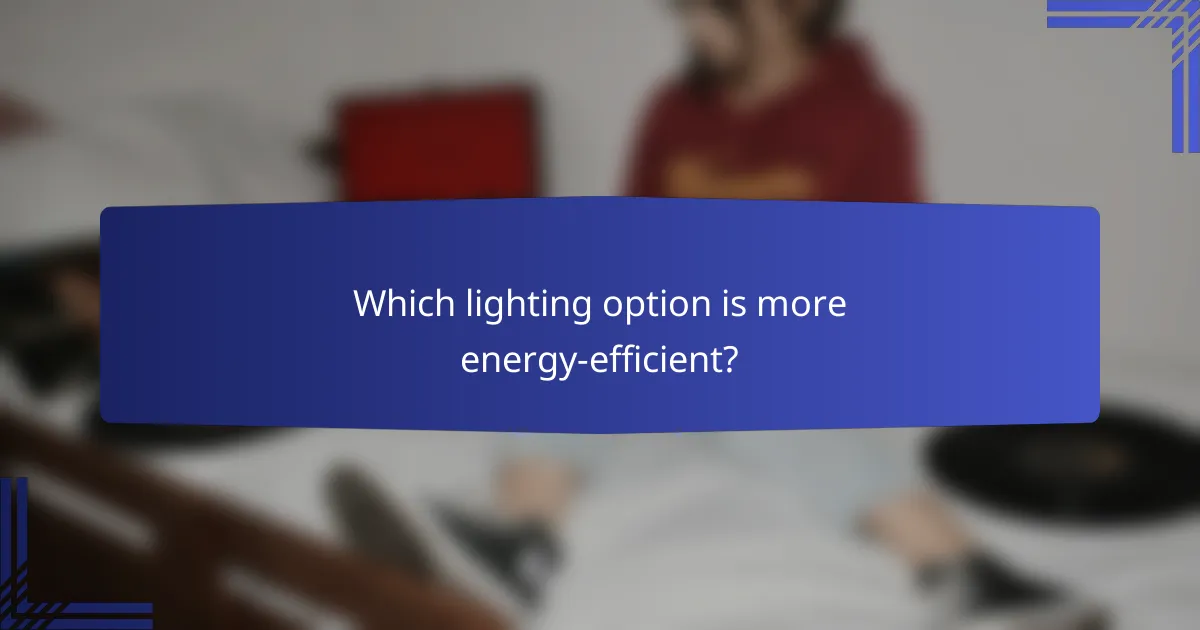
Which lighting option is more energy-efficient?
LED bulbs are significantly more energy-efficient than incandescent bulbs, consuming up to 80% less energy for the same amount of light output. This efficiency translates into lower electricity bills and a reduced environmental impact.
LED bulbs consume up to 80% less energy
LED bulbs operate using solid-state technology, which allows them to convert a higher percentage of energy into light rather than heat. This efficiency means that while an LED bulb may cost more upfront, it can save users substantial amounts on energy bills over time.
For example, a typical LED bulb uses about 10-15 watts to produce the same brightness as a 60-watt incandescent bulb. This significant reduction in wattage leads to lower energy consumption and longer lifespan, often exceeding 25,000 hours compared to around 1,000 hours for incandescent bulbs.
Incandescent bulbs have higher energy costs
Incandescent bulbs are less efficient because they waste a considerable amount of energy as heat rather than light. This inefficiency results in higher energy costs, especially in settings where lights are used for extended periods.
For instance, if you replace a 60-watt incandescent bulb with a 10-watt LED bulb, the savings can add up quickly. Over a year, using an LED instead of an incandescent can save around $100 or more, depending on local electricity rates and usage patterns.
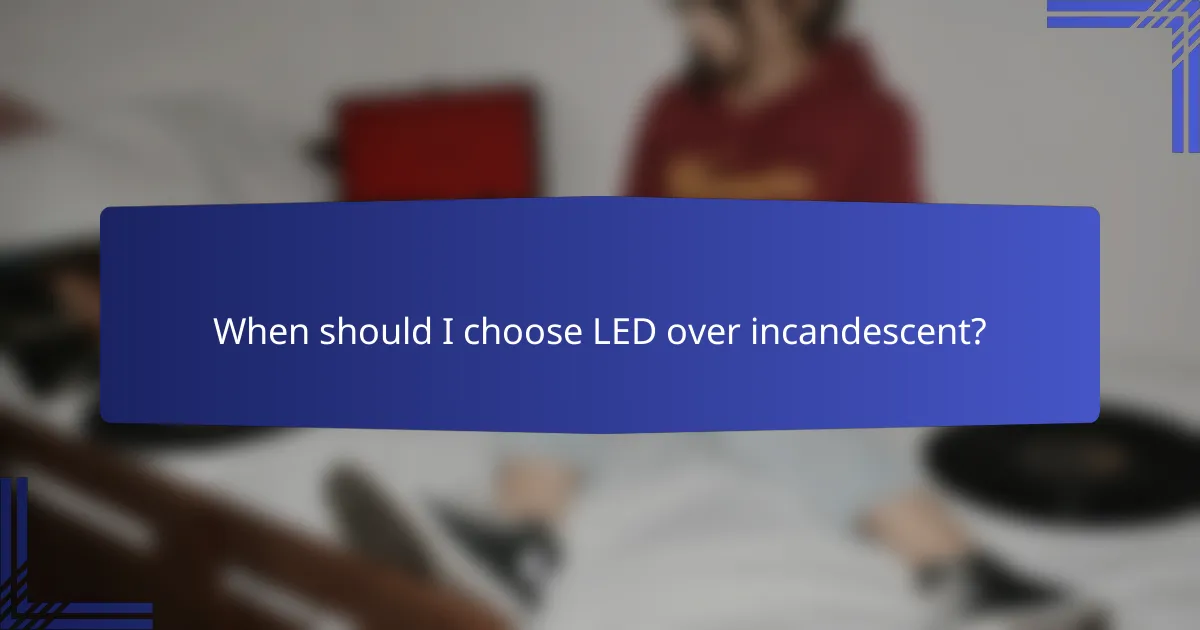
When should I choose LED over incandescent?
Choose LED lighting when you need energy efficiency and longevity, as they last significantly longer and consume less power than incandescent bulbs. Incandescents may be suitable for situations where immediate brightness is essential, but LEDs generally offer better long-term savings and performance.
LEDs for long-term use and savings
LEDs are designed for durability and energy efficiency, often lasting up to 25,000 hours or more compared to the 1,000 hours typical of incandescent bulbs. This longevity translates to fewer replacements and lower overall costs, making them a smart choice for both residential and commercial applications.
In terms of energy consumption, LEDs use about 75% less energy than incandescent bulbs, which can lead to significant savings on electricity bills. For example, replacing a 60-watt incandescent bulb with a 10-watt LED can save around $100 or more over its lifetime, depending on local electricity rates.
Incandescents for immediate brightness
Incandescent bulbs provide instant brightness when switched on, making them ideal for spaces where immediate illumination is necessary, such as in closets or stairways. Their warm light quality is often preferred for creating a cozy atmosphere in living areas.
However, keep in mind that while incandescents are inexpensive upfront, their higher energy consumption and shorter lifespan can lead to increased costs over time. If you choose incandescents, consider using them in fixtures where the light is only needed for short periods to minimize energy waste.
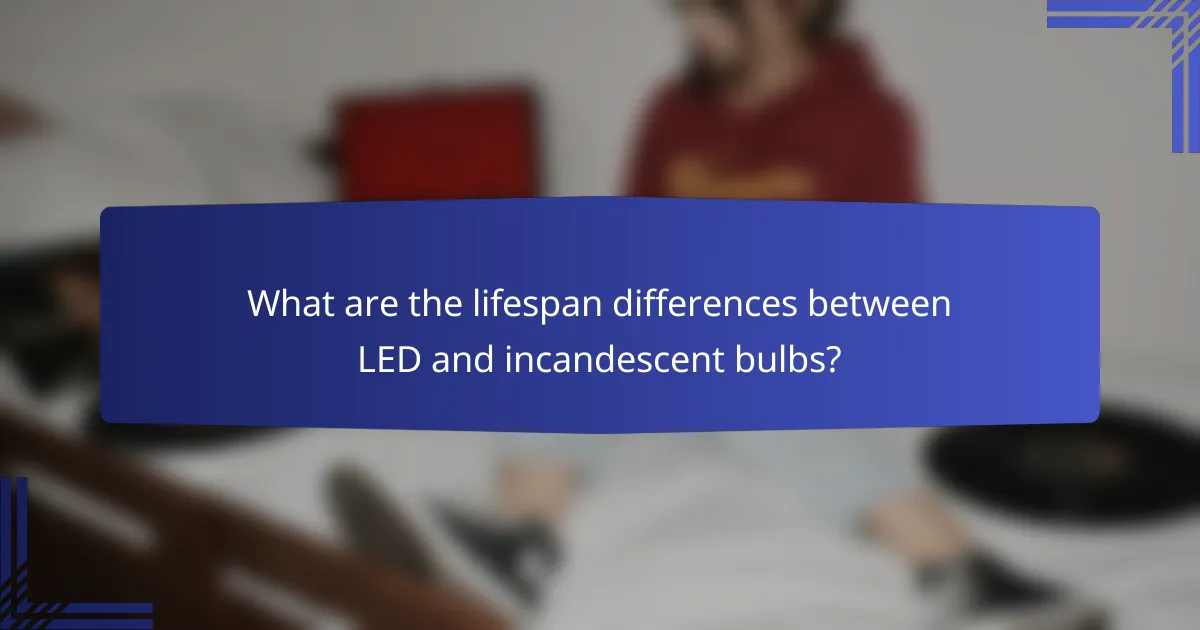
What are the lifespan differences between LED and incandescent bulbs?
LED bulbs significantly outlast incandescent bulbs, with lifespans that can be many times longer. Understanding these differences can help you make informed choices based on your lighting needs.
LEDs last up to 25,000 hours
LED bulbs typically have a lifespan ranging from 15,000 to 25,000 hours, making them a long-lasting option for various lighting applications. This extended lifespan means fewer replacements, which can save both time and money in the long run.
When considering LEDs, it’s essential to factor in their efficiency as well. They consume less energy than incandescent bulbs, leading to lower electricity bills over time. This combination of longevity and energy savings makes LEDs a practical choice for both residential and commercial use.
Incandescents last about 1,000 hours
Incandescent bulbs generally last around 1,000 hours, which is significantly shorter than LEDs. This limited lifespan means they need to be replaced more frequently, resulting in higher maintenance costs and waste.
While incandescents may provide a warm light quality that some prefer, their short lifespan and higher energy consumption make them less efficient. For those looking to reduce their environmental impact and save on energy costs, transitioning to LED lighting is a more sustainable option.

How do LED and incandescent bulbs compare in light quality?
LED and incandescent bulbs differ significantly in light quality, with each offering unique characteristics. LEDs can produce a range of color temperatures, while incandescent bulbs are known for their warm, yellowish light.
LEDs offer adjustable color temperatures
LED bulbs can emit light in various color temperatures, typically ranging from cool white (around 5000K) to warm white (around 2700K). This adjustability allows users to select the desired ambiance for different settings, such as bright white for task lighting or warmer tones for relaxation.
When choosing LED bulbs, consider the color temperature that best suits your space. For example, a cooler light may be ideal for kitchens or workspaces, while warmer light is often preferred in living rooms or bedrooms.
Incandescents provide warm, familiar light
Incandescent bulbs are celebrated for their warm, inviting glow, typically around 2700K. This light quality is often associated with comfort and familiarity, making it a popular choice for home environments.
While incandescents offer excellent color rendering, they are less energy-efficient than LEDs and have a shorter lifespan. If you prioritize warmth and traditional aesthetics, incandescents may be suitable for specific areas, but consider their higher energy costs and environmental impact over time.
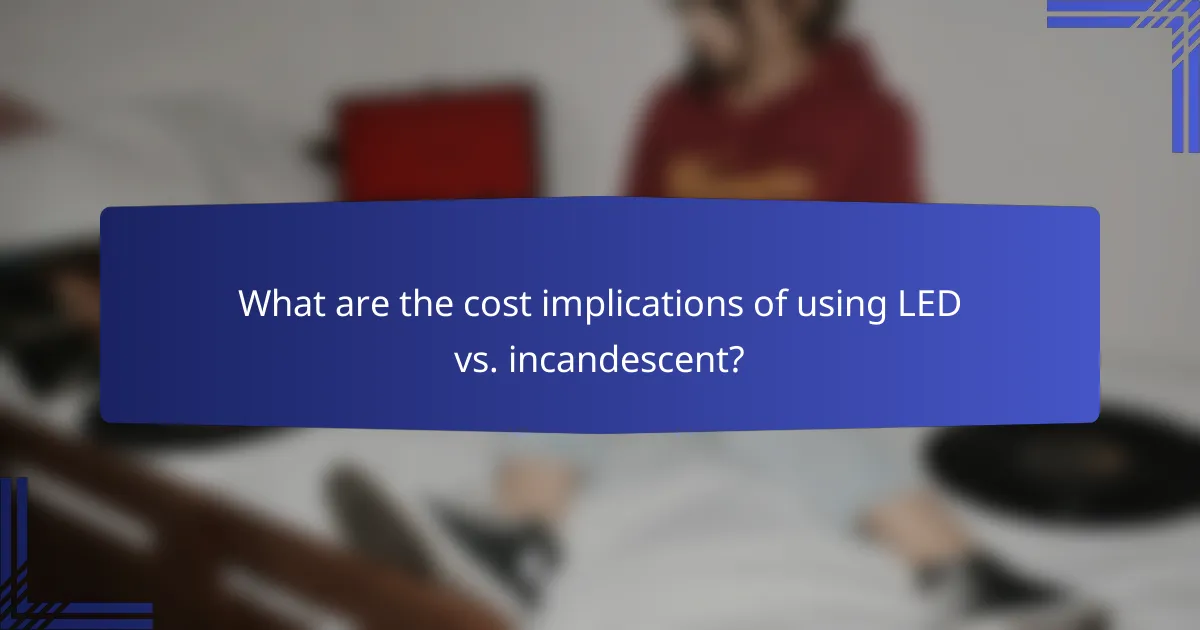
What are the cost implications of using LED vs. incandescent?
The cost implications of using LED versus incandescent bulbs primarily revolve around initial purchase prices and long-term energy savings. While LEDs have a higher upfront cost, they typically offer significant savings on electricity bills over time, making them a more economical choice in the long run.
LEDs have higher upfront costs
LED bulbs generally cost more than incandescent bulbs, often ranging from two to ten times the price depending on brand and features. This higher initial investment can deter some consumers, especially those on a tight budget.
However, the longevity of LEDs, which can last up to 25,000 hours or more, offsets the initial expense. Over time, the reduced frequency of replacements and lower energy consumption can lead to substantial savings.
Incandescents are cheaper to buy
Incandescent bulbs are typically less expensive, with prices usually falling in the low single digits. This affordability makes them an attractive option for immediate replacements or for those looking to minimize upfront costs.
Despite their lower purchase price, incandescents have a much shorter lifespan, averaging around 1,000 hours. This means that while the initial cost is lower, the total cost of ownership can be higher due to frequent replacements and higher energy bills.
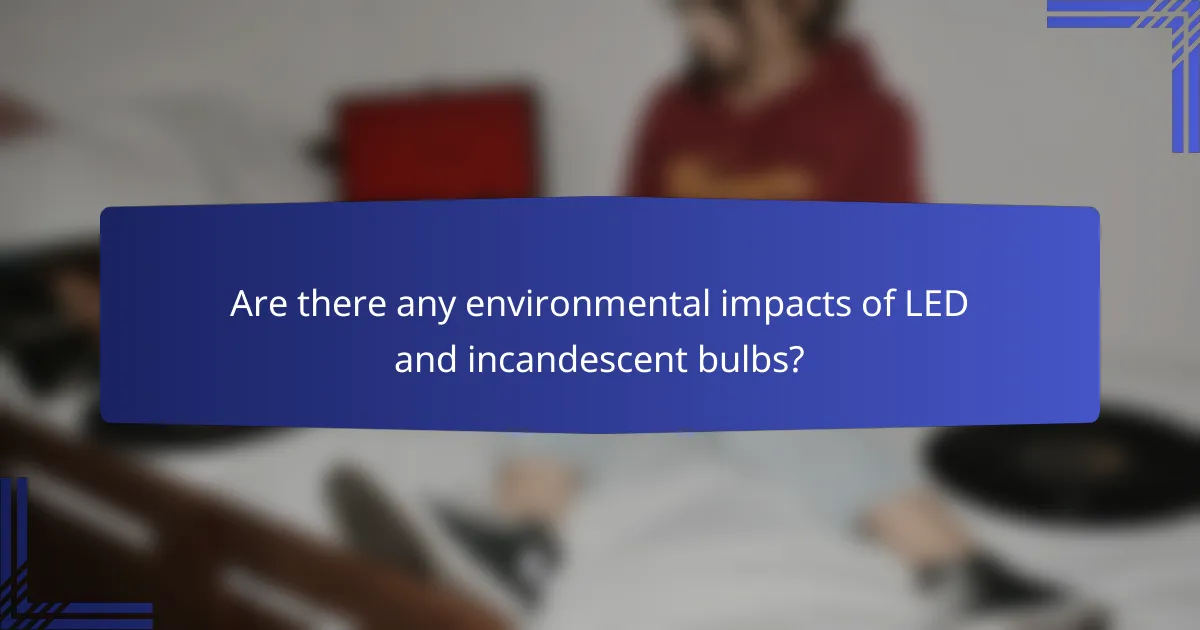
Are there any environmental impacts of LED and incandescent bulbs?
Yes, both LED and incandescent bulbs have environmental impacts, but they differ significantly. LEDs are generally more energy-efficient and have a lower overall carbon footprint compared to incandescent bulbs, which consume more energy and contribute to higher greenhouse gas emissions.
LEDs are more environmentally friendly
LED bulbs use significantly less energy than incandescent bulbs, often consuming about 75% less electricity. This efficiency translates to lower carbon emissions from power plants, especially in regions relying on fossil fuels for electricity generation. Additionally, LEDs have a longer lifespan, typically lasting up to 25,000 hours, which reduces waste and the frequency of replacements.
Moreover, many LED bulbs are made from recyclable materials, further minimizing their environmental impact. When considering lighting options, choosing LEDs can contribute to a more sustainable energy future.
Incandescents have higher carbon footprints
Incandescent bulbs are less energy-efficient, converting only about 10% of the energy they consume into visible light, while the rest is wasted as heat. This inefficiency results in higher electricity bills and increased carbon emissions, particularly in areas where electricity is generated from non-renewable sources.
Furthermore, the shorter lifespan of incandescent bulbs, usually around 1,000 hours, leads to more frequent replacements, contributing to greater waste. As a result, using incandescent bulbs can have a more pronounced negative impact on the environment compared to their LED counterparts.

What are the safety considerations for LED and incandescent bulbs?
Safety considerations for LED and incandescent bulbs vary significantly due to their design and operational characteristics. LEDs are generally safer, producing less heat and posing fewer fire risks, while incandescent bulbs can generate high temperatures and potentially lead to hazardous situations.
LEDs produce less heat
LED bulbs operate at a much lower temperature compared to incandescent bulbs, which means they are less likely to cause burns or ignite surrounding materials. Typically, LEDs convert a higher percentage of energy into light rather than heat, making them more efficient and safer for prolonged use.
This lower heat output makes LEDs suitable for use in enclosed fixtures and in areas where heat buildup is a concern, such as near flammable materials. When choosing lighting for sensitive environments, opting for LEDs can significantly reduce safety risks.
Incandescents can pose fire risks
Incandescent bulbs generate substantial heat during operation, which can lead to fire hazards if they come into contact with flammable objects or materials. The high temperatures can also damage light fixtures and wiring over time, increasing the risk of electrical fires.
To mitigate these risks, it is crucial to use incandescent bulbs in well-ventilated areas and to avoid using them in enclosed fixtures unless they are specifically rated for such use. Regularly checking for signs of wear or overheating can help prevent potential fire hazards associated with incandescent lighting.

How do I choose the right bulb for my home?
Choosing the right bulb for your home involves considering factors like room size, purpose, and energy efficiency. Understanding these elements helps you select the most suitable lighting solution for your needs.
Consider room size and purpose
The size and function of a room significantly influence the type of bulb you should use. For larger spaces, such as living rooms, brighter bulbs with higher lumens are essential to provide adequate illumination. In contrast, smaller rooms like bathrooms or hallways may only require lower-lumen bulbs.
Additionally, consider the purpose of the room. Task lighting in kitchens or offices benefits from bright, focused bulbs, while ambient lighting in bedrooms can be softer and warmer. This distinction helps create the right atmosphere for each space.
Evaluate energy savings over time
Energy efficiency is a crucial factor when selecting bulbs, as it impacts both your electricity bill and environmental footprint. LED bulbs typically consume significantly less energy than incandescent bulbs, often using around 75% less electricity. This difference translates to lower costs over time.
When evaluating energy savings, consider the lifespan of the bulbs as well. LEDs can last up to 25,000 hours, while incandescent bulbs may only last about 1,000 hours. Although LEDs may have a higher upfront cost, their longevity and efficiency often result in better long-term savings.
